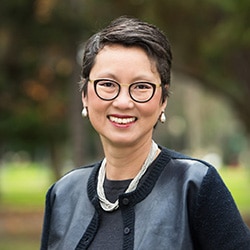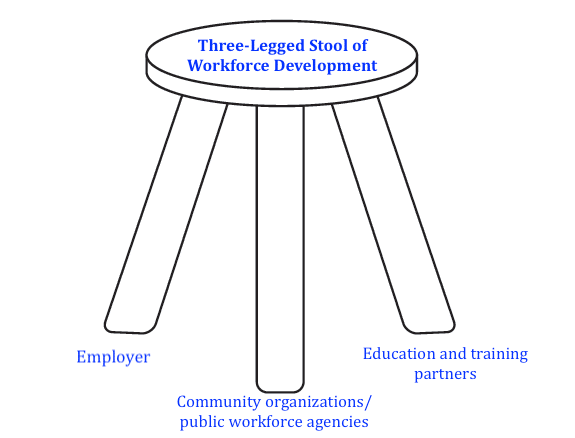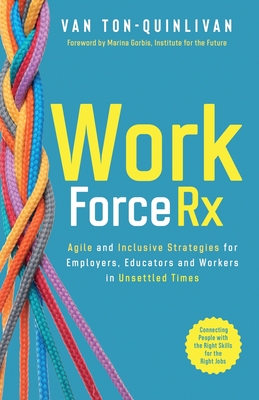Having escaped with her family from the Vietnam War to start again in the U.S., Van Ton-Quinlivan is passionate about paying forward the opportunities that an education afforded her. She has built a career as a highly impactful workforce development expert and currently serves as CEO of Futuro Health, a nonprofit with the mission of improving the health and wealth of communities by growing the largest network of credentialed allied healthcare workers in the nation.
In this episode of the Leading Learning Podcast, co-host Celisa Steele and Van discuss the three-legged stool of workforce development, creating a high-quality talent pool, the benefit of having clearly articulated goals, and the essential role an ecosystem of partners plays in delivering scale, equity, and agility.
To tune in, listen below. To make sure you catch all future episodes, be sure to subscribe via RSS, Apple Podcasts, Spotify, Stitcher Radio, iHeartRadio, PodBean, or any podcatcher service you may use (e.g., Overcast). And, if you like the podcast, be sure to give it a tweet.
Listen to the Show
Access the Transcript
Download a PDF transcript of this episode’s audio.
Read the Show Notes
[00:00] – Intro
[01:52] – Information about Van’s expertise and experience in workforce development and about Futuro Health.
Setting a Goal, Designing for Scale
[04:26] – Futuro Health has a goal to graduate 10,000 new licensed and/or credentialed workers by 2024 to meet the nation’s critical demand for healthcare workers. How did you come up with that goal? What value do you see in having articulated that goal and publicly committed to it?
Futuro Health wanted to put a line in the sand because its challenge was scale. Given the magnitude of the labor shortage in allied healthcare, Futuro Health needed to figure out how to design an education journey that worked for diverse adults and do it at scale.
In just two years Futuro Health has gone from zero to helping over 5,000 adult students seek a credential. They’ve had to design workflows and partnerships that can handle that scale and also provide the live touches that are so important, especially to diverse adult students.
That was the reason why we put a line in the sand, to challenge ourselves to design for scale, to design for equity, and to design for agility.
Van Ton-Quinlivan
Agility is also key because things are shifting so fast in healthcare. For example, when the pandemic hit, suddenly healthcare cut over to telehealth, which was an entirely new way of interacting with patients. With skill sets changing dramatically and quickly, having an ecosystem that could deliver on scale, equity, and agility was the goal for Futuro Health—and they’ve realized that goal.
[07:35] – Would other organizations benefit from being specific and explicit, and possibly even public, about their goals?
Van has always found it helpful to put a line in the sand as a challenge not only to her own organization but also for board members and other stakeholders. It also brings in support and focus. She would encourage everybody to have a quantifiable North Star.
Sponsor: BenchPrep
[08:34] – We’re grateful to BenchPrep for sponsoring the Leading Learning Podcast.
BenchPrep is an award-winning learning platform purpose-built to help learners feel confident and prepared to take difficult entrance, certification, and licensing tests by delivering an intuitive, efficient, and engaging study experience. BenchPrep helps you accelerate test prep revenue growth by offering the tools you need to create market-ready products and data to improve your content and understand learner behavior.
Many of the world’s leading associations, credentialing bodies, test providers, and training companies trust BenchPrep to power their online study programs, including ACT, the Association of American Medical Colleges, CFA Institute, CompTIA, GMAC, McGraw-Hill Education, AccessLex, and more. More than 8 million learners have used BenchPrep to attain academic and professional success. To discover more, visit BenchPrep.
The Three-Legged Stool of Workforce Development
[09:39] – How do you define “workforce development”?
Every employer’s goal is to have the right person with the right skills at the right time. If an employer isn’t able to achieve that goal by posting a job opening, then it’s time to do some intentional workforce development. Currently, employers are reporting shortages across most industries.
One of the…misconceptions that employers have is that they have to do this workforce development on their own, in a silo. There’s actually great value in partnering.
Van Ton-Quinlivan
Van shares the three-legged stool of workforce development, where each party does what it does best.
- Employers
Employers articulate what they need. They define the specs of what it means to have the right person with the right skills at the right time, including diversity and inclusion goals. Employers also hire or create internships. - Community organizations and public workforce agencies
These organizations and agencies go into the community and do outreach to expand and bring in the talent pool. They also serve two very important functions in addition to outreach. They can screen against employers’ criteria and case-manage candidates through the education process. - Education and training partners
These partners close the gap between what employers want and where the candidates are.
Changes and Trends in Workforce Development
[14:28] – How have you seen workforce development evolve?
There have been a few changes:
- Educational institutions are embracing partnership with employers more.
Educational institutions are looking to stay relevant and current, but the cycle of curriculum development is challenging. When employers make the latest and greatest information and insights to educational institutions, it is very helpful. You can see that strategy in Grow with Google, Amazon, and IBM. Many are helping to grow a relevant talent pool by a making these resources available so that education institutions don’t have to guess what is relevant. - Corporations have come to realize it is in their interest to make training and development and tuition disbursement available to their frontline and lower-level staff.
It used to be high-potential employees got all the training resources, but companies, ranging from Walmart to Disney to Starbucks, have all made tuition disbursement available to frontline employees. That helps the employees build skills and credentials, and it helps employers retain talent.
Credentialing and Workforce Development
[16:22] – What have you seen work well with credentialing and workforce development?
Most of our education system is set up so you get your highest level of education upfront, and you never have to do anymore skilling for the rest of your life. But the reality is you need upgrades throughout life.
To address affordability and the speed of change, we need skills delivered in shorter bursts. It’s challenging for many to put in the time for a whole degree, and, for those that do, by the time they get the degree, the skill sets may be out of date. Microcredentials and other shorter-to-attain credentials are ways to get those skills upgrade.
The challenge for those in the education and training space is to make sure that the credentials carry value, especially if financial aid is associated with them. If there’s abuse of shorter-to-attain credentials, then those public funds will go away.
Adults are not in a mood right now to go find degrees. You can see that in the drop in enrollment numbers. But they are up for skilling up as a way to ensure that they remain relevant. Offering burst, shorter ways to attain those skills in the form of these credentials and microcredentials is very valuable in this labor market.
Van Ton-Quinlivan
Also, adults don’t want to start from scratch so it’s important to design credentials and microcredentials to stack. The more stackability, the less cumbersome it is for adults to build their skills.
Creating a Successful Ecosystem of Partners
[19:38] – What advice do you have for organizations looking to create successful partnerships? What contributes to good partnerships, and what tends to not work?
All sorts of partnership configurations are possible. Consider what problems you can solve through partnerships that you can’t solve alone. The best partners bring what they do best to the table. Partners shouldn’t come to the table with their hands out, asking for resources. Partners have to bring value to the collaboration.
Van shares how, because of good partnerships, Futuro Health was able to train over 4,000 healthcare workers in 20 states within two and a half weeks to prepare for the first COVID surge. That’s the kind of agility that is needed in a crisis. It would be very challenging for a single organization to pull that off, but an ecosystem of partners can pull off a solution. There’s no organization that has all the resources or even the interest or the competencies to tackle what lies ahead.
Aligning Training and Education with Employer Needs
[23:22] – How can organizations come to better understand employer needs so that they make sure whatever they’re offering in terms of training, education, and lifelong learning aligns with employers’ need?
Van began documenting lessons learned and playbooks that work in workforce development in her book WorkforceRx: Agile and Inclusive Strategies for Employers, Educators, and Workers in Unsettled Times.
There’s a little bit of an art and science in getting the skill sets right. Listen to the pain points of the employer. Is the pain point recurring or one-time? Also assess the timing of the pain point.
Van shares an example from the book related to electric vehicles being manufactured so fast there weren’t people trained to work on them. She helped select seven colleges as training partners. They got permission from the manufacturer to train those colleges on how to work with electric vehicles. Then those seven colleges went on to train the 300 mechanics within a two-month window.
They fed that curriculum and knowledge into the public system or education institutions. Now the faculty will be able to produce mechanics with electric vehicle skills. Industry has now seeded that knowledge into the normal production of students and has created a talent pool.
Van also helped with a challenge related to so many master mechanics on the verge of retirement, without anyone to replace them with. Because this was a much smaller volume in terms of need, they only picked one college and selected 25 mechanics from within their ranks and the ranks of their supply chain. The selected students attended a dedicated summer program, and at the end the master mechanic decided if they’d be eligible for the slots coming available. The master mechanic gave out an individual development plan to each person. They then had to seek out projects to fill their knowledge and skills gaps so they’d be eligible for the master mechanic positions that would open up later.
Designing for Diversity, Equity, and Inclusion
[29:47] – What do you see as the role for Futuro Health and other learning providers in diversity, equity, and inclusion?
There’s a lot of conversation about diversity and inclusion, but can it be translated into action? Van thinks about what Lego pieces need to come together in order for diverse candidates to successfully make it through education. In almost all cases, it’s not the instructional design alone. There needs to be a high level of touch, coaching, navigation, and supports. There also needs to be a confidence-building onramp because many of these adults didn’t have a great experience in education the first go-round. They may have some trepidation about reengaging in education. Language skills may also get in the way.
The biggest thing Van sees is that candidates’ lives and families aren’t structured in a way that supports them in their studies. The onramp has been designed into Futuro Health, and it’s why so many diverse adults are finding the education journey supportive for them. Van shares a story to articulate the value of the three-legged stool of workforce development to highlight the point that.
If we do what we all do best, then we can reach into a deeper, wider, and more diverse talent pool. And none of us have to bear more than we need in terms of the responsibility and the resourcing.
Van Ton-Quinlivan
[34:30] – Wrap-up
Van Ton-Quinlivan is CEO of Futuro Health and author of WorkforceRx: Agile and Inclusive Strategies for Employers, Educators, and Workers in Unsettled Times. Van also hosts the WorkforceRx podcast.
To make sure you don’t miss new episodes, we encourage you to subscribe via RSS, Apple Podcasts, Spotify, Stitcher Radio, iHeartRadio, PodBean, or any podcatcher service you may use (e.g., Overcast). Subscription numbers give us some visibility into the impact of the podcast.
We’d also be grateful if you would take a minute to rate us on Apple Podcasts at https://www.leadinglearning.com/apple. We personally appreciate reviews and ratings, and they help us show up when people search for content on leading a learning business.
Finally, consider following us and sharing the good word about Leading Learning. You can find us on Twitter, Facebook, and LinkedIn.
Episodes on Related Topics:






 Unbundling the Future of Learning with UPCEA’s Jim Fong
Unbundling the Future of Learning with UPCEA’s Jim Fong
Leave a Reply